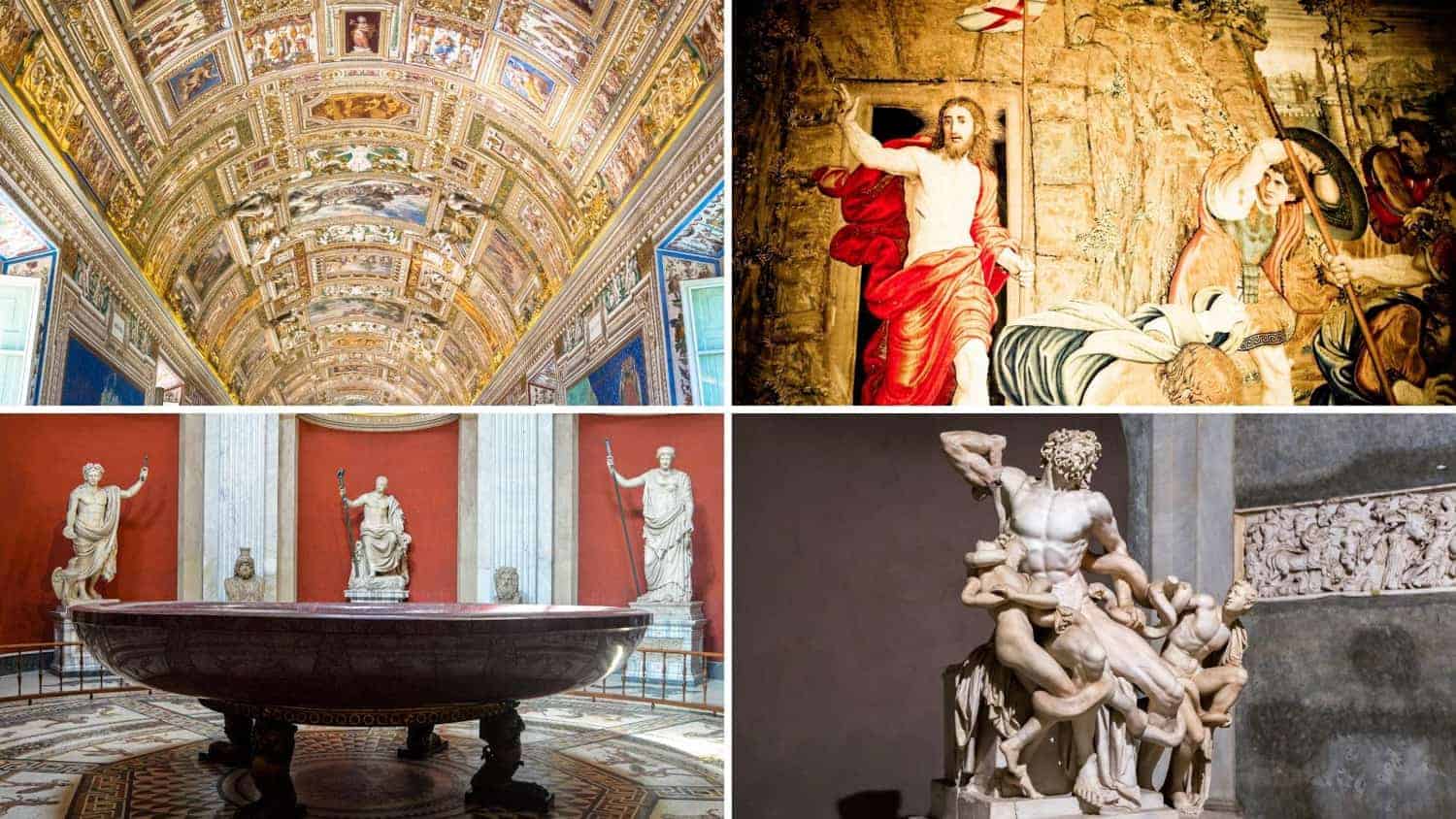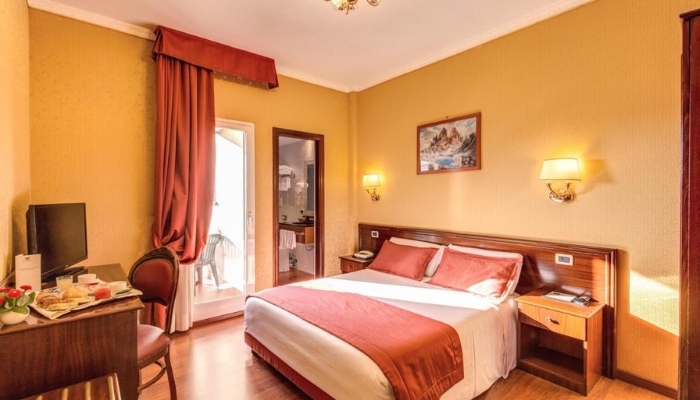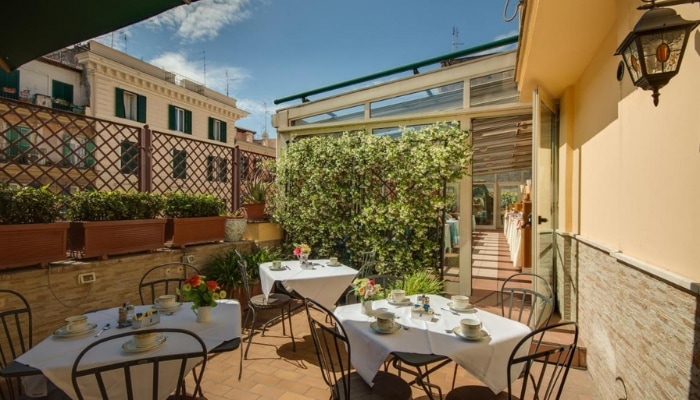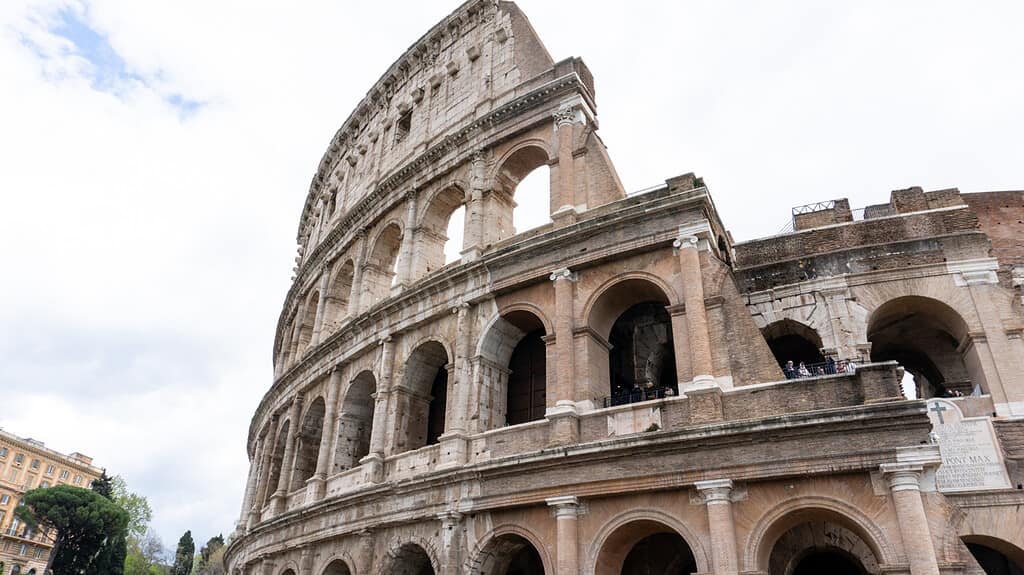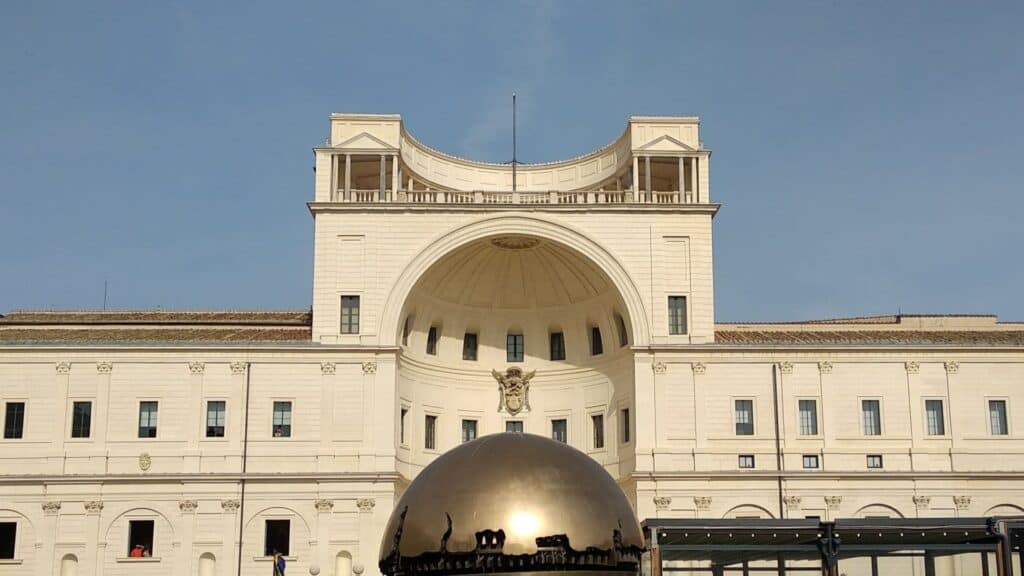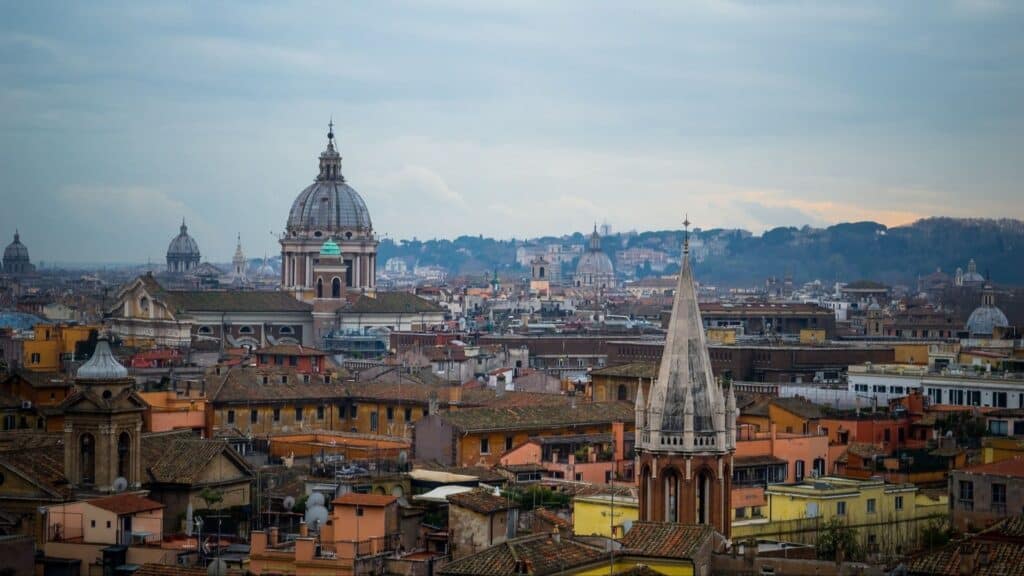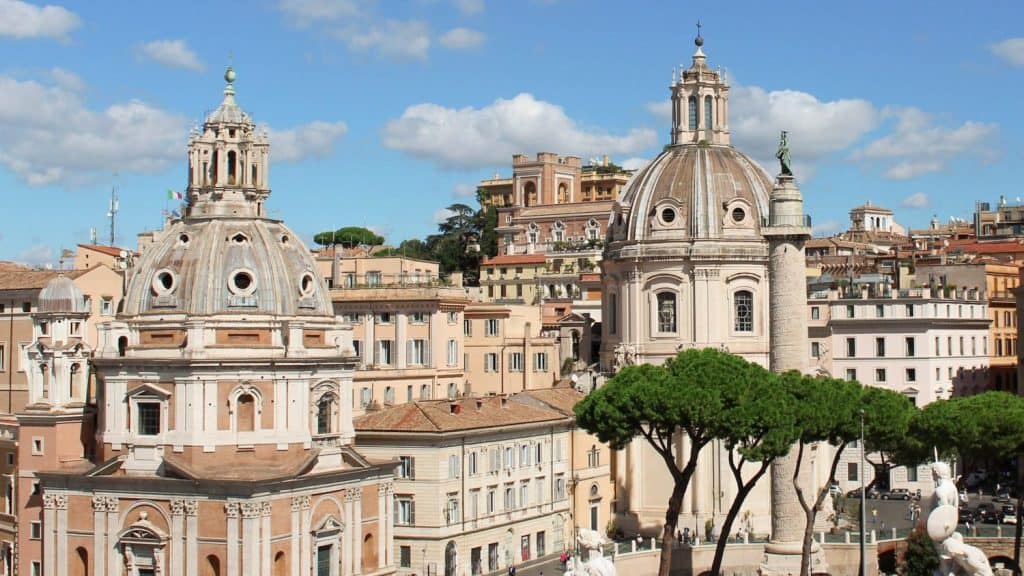The Vatican Museums are one of the most popular museums in the world. In 2020, they were the 5th most visited museum. In Europe, only the Louvre (the first place in the world with almost double attendance) and the Tate Modern in London skipped them. In this guide you will find out where to enter the Vatican Museums, where to book your tickets, what the opening hours are and, above all, what to see and not miss at the Vatican Museums.
We update admission fees, opening hours and other useful information for the Vatican Museums several times a year. The latest update is always listed at the beginning of the article.
- A quick overview for the Vatican Museums
- Interesting facts about the Vatican Museums
- Entrance
- How to skip the line for the Vatican Museums
- Opening hours 2024
- Tickets and admission to the Vatican Museums 2024
- When to visit the Vatican Museums?
- What to see in the Vatican Museums?
- Tips before visiting
- Booking tickets for the Vatican Museums and the Sistine Chapel
- Map of Vatican
- How to save in Rome on transport and admission?
- Accommodation in Rome
- More about Rome
- Frequently asked questions about the Vatican Museums
A quick overview for the Vatican Museums
Admission for the Vatican Museums
Admission to the Vatican Museums varies depending on whether you buy tickets on the spot or in advance. Tickets are cheaper at the door – full admission is €20 and reduced admission is €8 (children over 6 and students under 26). Children up to 6 years of age and disabled children with disability over 74% are admitted free of charge.
We booked our tickets in advance and I would recommend it to anyone planning to visit the Vatican Museums – we didn’t even wait 5 minutes at the venue, including the security check.
Also think about the fact that there aren’t as many options in museums where you can relax and get a lot of walking in. For this reason, I recommend coming while you are rested, as the tour can be really tiring. Especially if you go with children.
How to skip the queues for the Vatican Museums?
The Vatican Museums are famous for their queues. The queue snakes around the corner along the walls, and more crowds keep streaming in from St Peter’s Square.
The easiest way to skip the queues is to book tickets in advance. There are three separate lines at the venue – the ticket line on the left, the middle line if you have a reservation, and the line for guided tours on the right.
You come to the middle line where you show the staff your tickets on your mobile phone. It will scan the QR code and you can go straight in for the security check.
Even at the time of the biggest queue (see photo above), we didn’t wait for a reservation at all and went straight in.
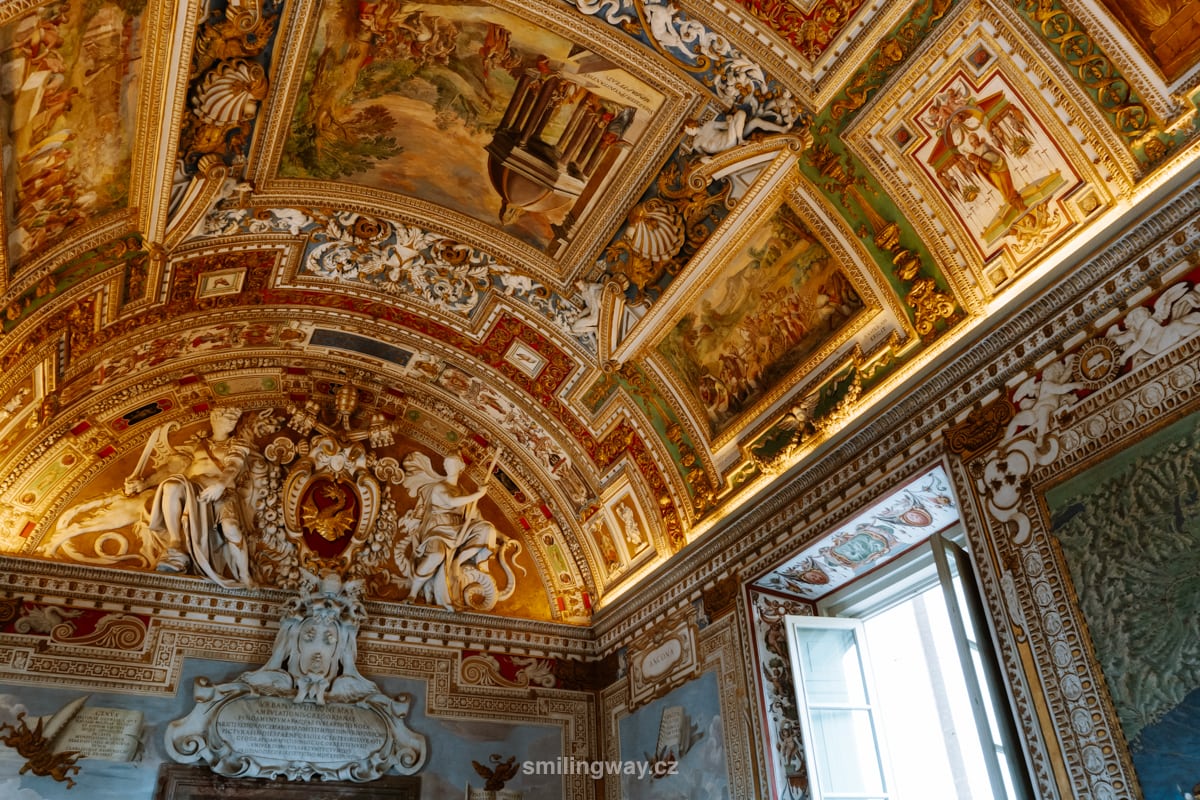
What to do if tickets to the Vatican Museums are sold out?
A very common reality – tickets to the Vatican Museums can sell out weeks in advance. In this case I recommend a guided tour. There are several to choose from and plenty of dates available. This is an increasingly popular way to visit the Vatican Museums.
Another option is to queue – arrive before opening hours to keep the queue to a minimum.
Interesting facts about the Vatican Museums
The Vatican Museums are public art and sculpture museums in the Vatican complex, located in the former wings of the Vatican Palace. It tells the story of the rise and fall of the Roman Empire, the history of the Catholic Church and the birth of the Renaissance.
Much of the art was collected by Pope Julius II. He was known for his wartime missions, from which he managed to amass a huge collection. He had the St Peter’s Basilica into its present form and in 1506 he founded the Vatican Museums.
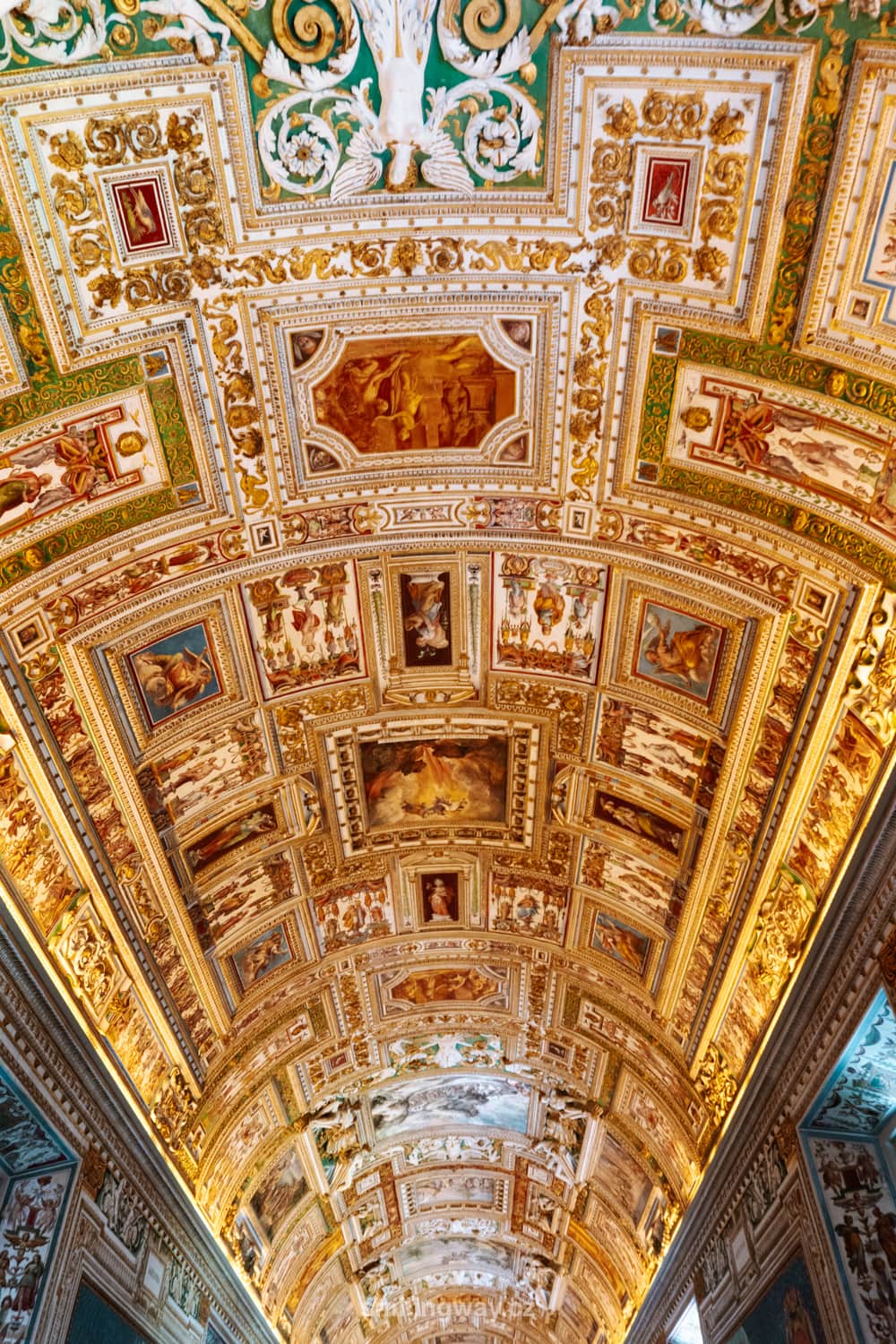
Entrance
Entry to the Vatican Museums depends on which you plan to visit first – the Vatican Museums or St Peter’s Basilica.
- If St Peter’s Basilica, the entrance to the Vatican is from St Peter’s Square. Before entering the Basilica, you will go through a security check and after the tour of the Basilica, you will go to the right along the walls to the Vatican Museums (about 15 minutes), where another security check awaits you.
Please note: On Wednesdays the Pope has an audience and the Basilica does not open until 12:30-13:00.
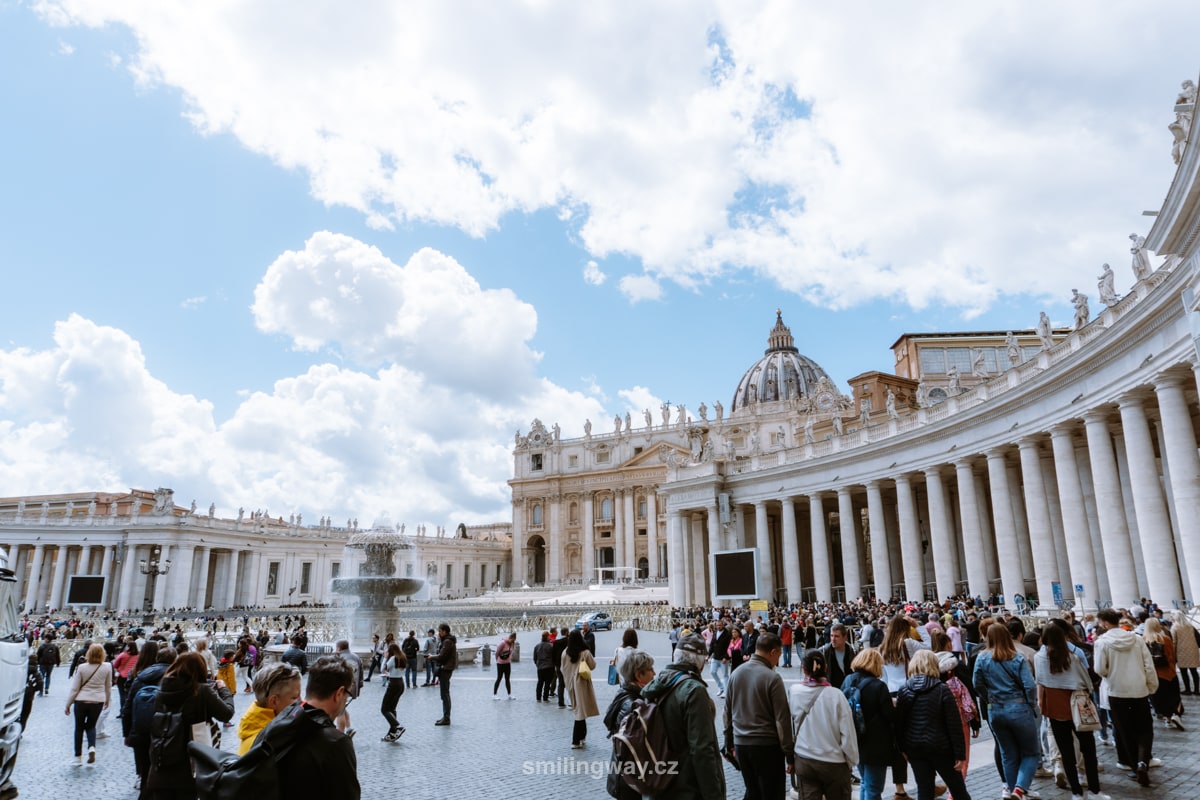
- Would you rather visit the Vatican Museums and the Sistine Chapel first? The entrance here is from Viale Vaticano. The easiest way to reach the museums is to take the red line A of the Roman Metro (free transport with the Roma Pass). You get off like most visitors at Ottaviano station, where you follow the crowds to the museums and after a few minutes walk along the walls to the entrance.
Or you can get off at the next stop, Cipro. The walking time is about the same from both stops (10-15 minutes), but the Cipro stop has one advantage – they make excellent pizza, which the locals come here for, and the queues can sometimes be quite long. You can choose between Roman and Neapolitan dough.
Upon entering, you will again be subject to a security check at the Vatican Museums. After the tour, you can go to the Basilica of St. Peter, where you’re waiting in line next.
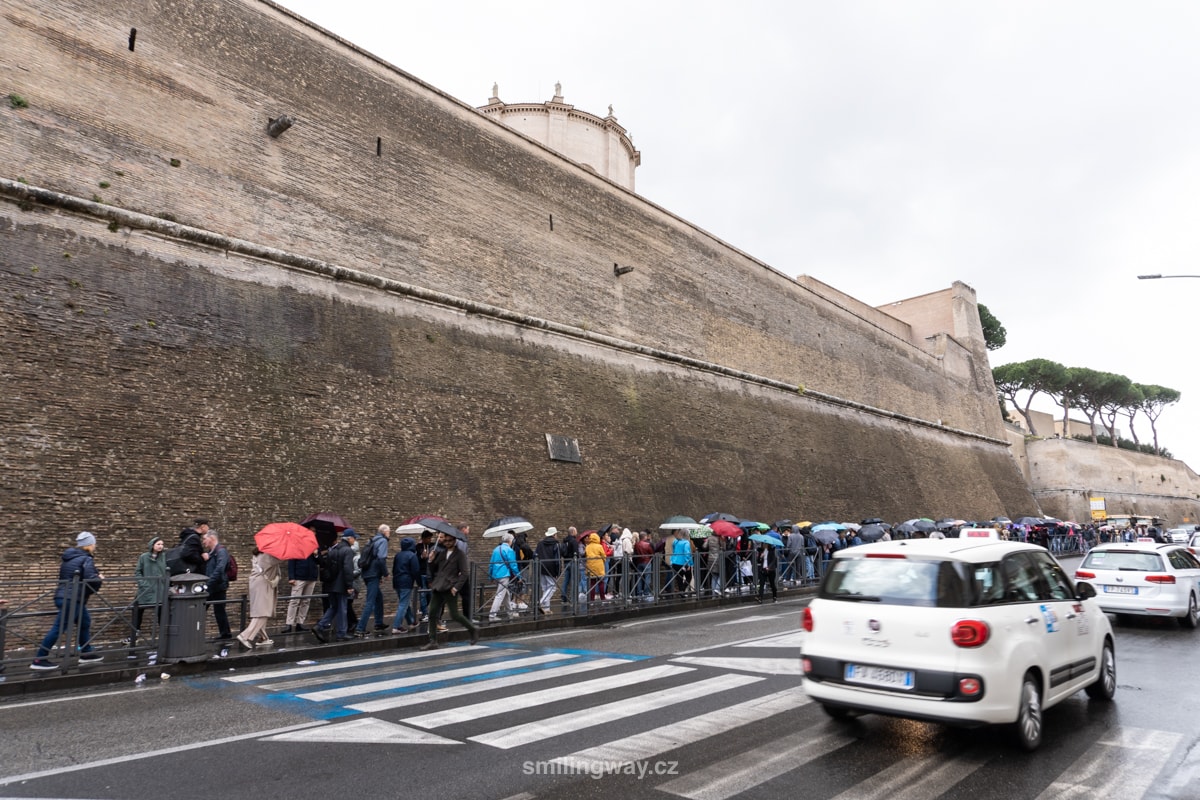
How to skip the line for the Vatican Museums
In the photo above, you can see the queue for tickets – taken in mid-April, in the middle of the week, when Rome’s peak season had not yet started. The queue goes all the way around the corner where the entrance to the Vatican Museums is (see photo below).
The only way to avoid the queue is to buy tickets in advance. You’ll pay a few euros more, but you won’t have to wait hours to enter the Vatican Museums.
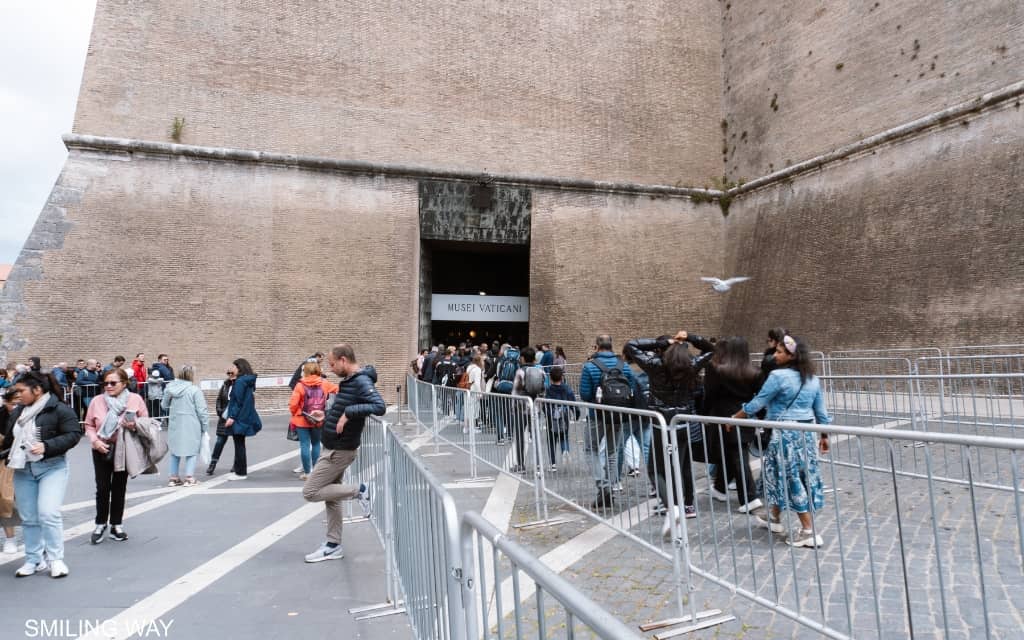
If you have tickets in advance, you will go through the middle line, which always takes priority over the ticket line. You automatically get inside, where you pass through a security checkpoint and in a few minutes you are inside the museums. Here you will climb the stairs to reach the entrance to the museums.
We had tickets booked in advance and we were inside in 5 minutes, even with the security check (and it was really crowded in the museums).
On the other hand, you will have to wait in line for tickets. Once those with advance reservations have passed through, a staff member will let in a smaller group of those without reservations. Then he closes the barrier again and lets the others through when the ones with reservations have passed.
If you are visiting the Vatican Museums with a guide, you will take the entrance on the right (see previous photos).
Previously, you could take a shortcut directly into the basilica and not have to stand in another security line. This is no longer possible these days, unless you visit the Vatican Museums as part of guided tours (this may not always be the case – check before booking).
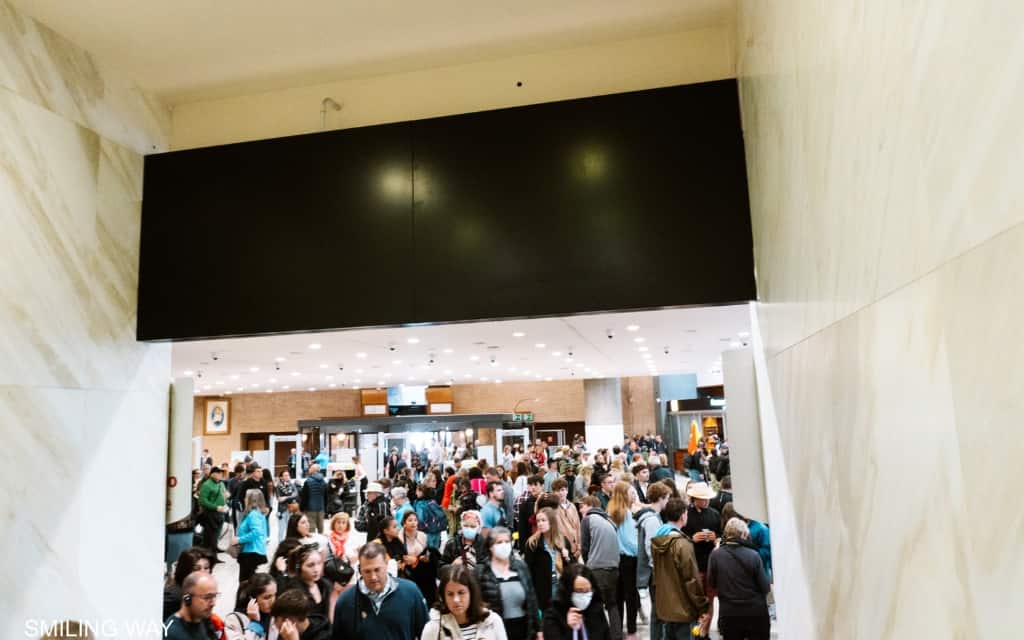
Opening hours 2024
The Vatican Museums are open Monday to Saturday from 8:00-19:00 (last entry at 17:00). Since March, the opening hours in the high season on Fridays and Saturdays are extended until 20:00 (last entry at 18:00).
Closed on Sundays except the last Sunday of the month when it is open 9:00-14:00 (last entry at 12:30).
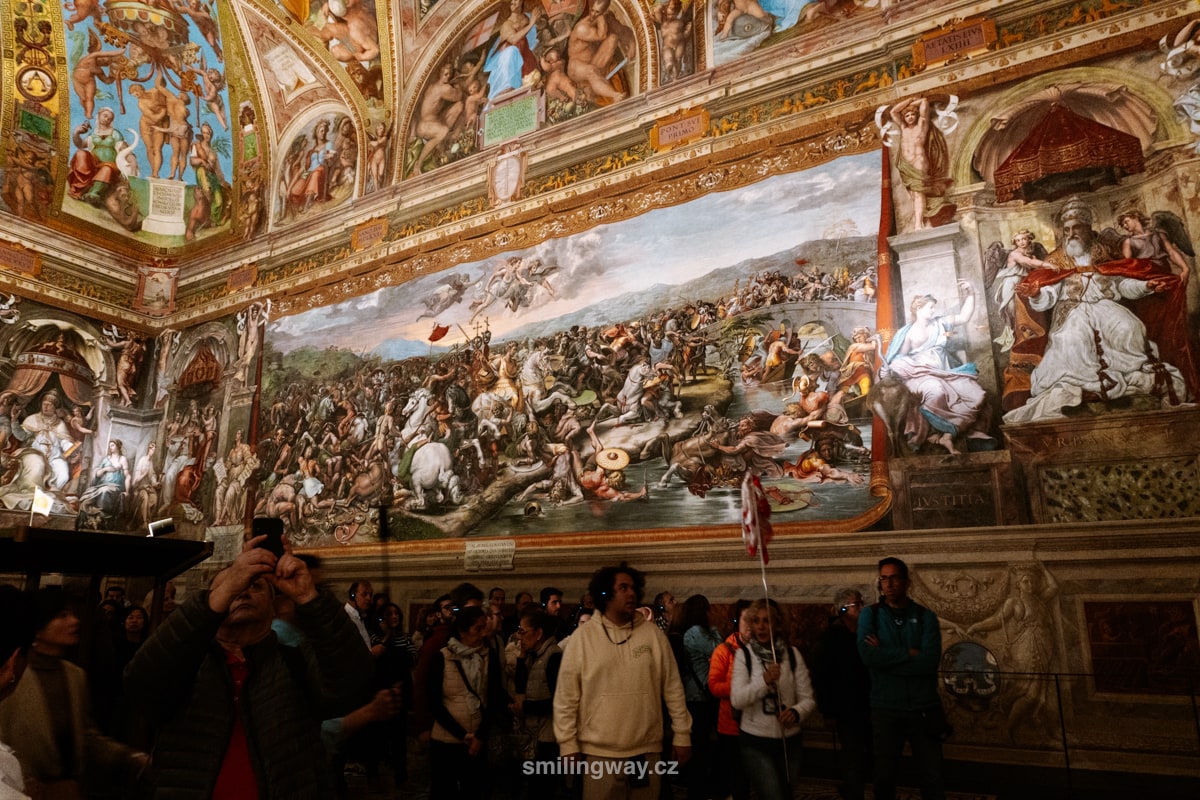
When is it closed in the Vatican?
It is closed on all Sundays except the last one, when admission is free. The Vatican Museums are also closed on Catholic holidays:
- 1st January
- January 6 at the Three Kings
- 31 March and 1 April for Easter
- May 1 to celebrate the workers
- June 29 on the feast of St. Peter and Paul
- 14 and 15 August for the celebration of the Assumption of the Virgin Mary
- November 1, All Saints’ Day
- 25 and 26 December to celebrate the birth of Jesus Christ
Tickets and admission to the Vatican Museums 2024
Full admission to the Vatican Museums costs €20 and reduced admission costs €8 (children over 6 and students under 26). Children up to 6 years of age and disabled children with disability over 74% are admitted free of charge.
Where to buy tickets to the Vatican Museums? You can buy tickets on the spot, but be prepared for the long queues for which the Vatican Museums are famous – see photo above. Up to 30,000 people come here every day and you can spend up to 3 hours in line. There’s a lot to see inside, so I recommend buying tickets in advance so you can go straight to the museums and not wait in line.
Tip: Book your tickets for the Vatican Museums in advance, skip the queue on the left and go straight to the entrance. It’s quick – for us, we were inside in 5 minutes, even with the security check.
In high season, book at least a few days to weeks in advance to avoid selling out. When you purchase a ticket, you reserve a specific time of entry. So if you book entry to the Vatican Museums for 14:00, you should arrive between 13:45 and 14:15 (in our experience, they let you in earlier – they didn’t look at the time).
Another way not to cost a security check is to order a guided tour who will highlight the best pieces of a huge collection that’s easy to get a little lost in.
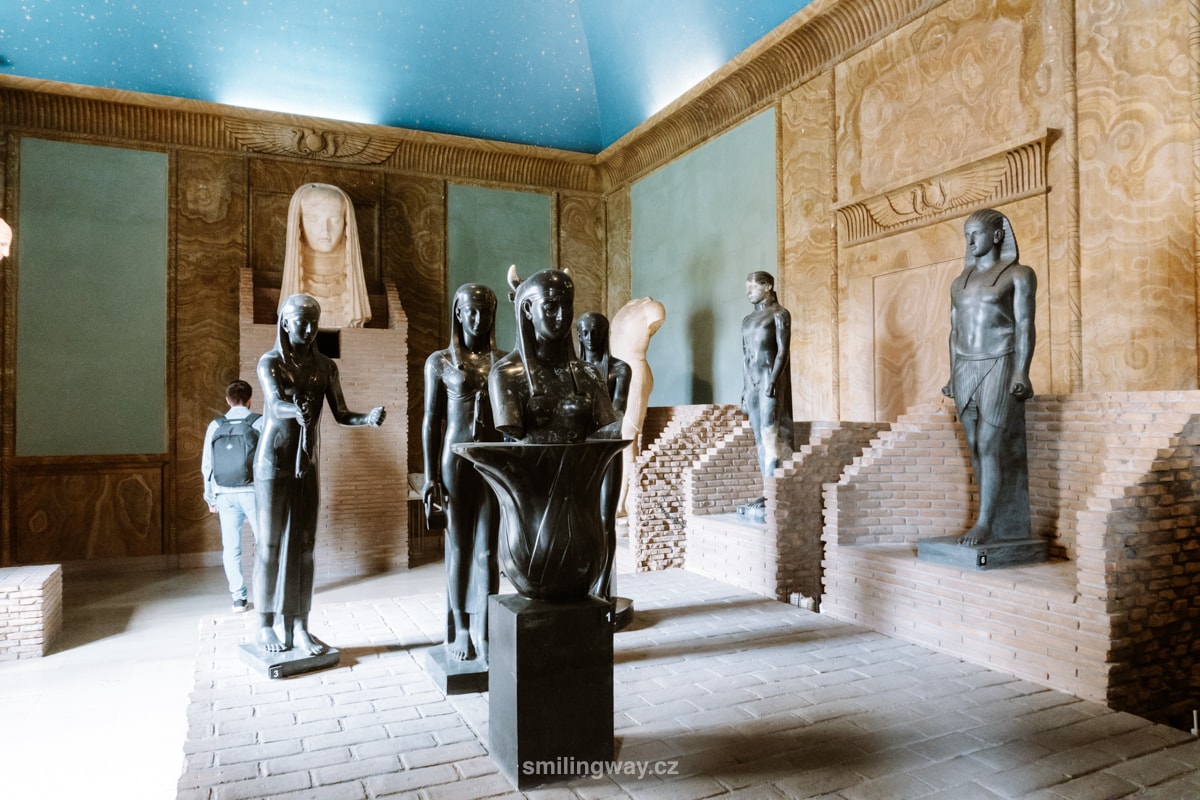
When to visit the Vatican Museums?
One thing is certain – the queues for the Vatican Museums can be long. Standing for more than an hour and a half in high season is not unusual (especially on the last Sunday of the month, when admission is free).
The queue stretches along the wall and you can see it before the actual entrance to the museums. The same on Svatopetrské náměstí, when the queue winds around the colonnade.
So when is the best time to visit the Vatican Museums?
November, January, February and March until Easter are the quietest months with the smallest crowds. The high season in the Vatican starts after Easter and especially in the summer months (June, July, August) some rooms can be so full that you stand still (for example, the Sistine Chapel or Raphael’s rooms). Many people are not corrected and there is warm and heavy air inside on warm days.
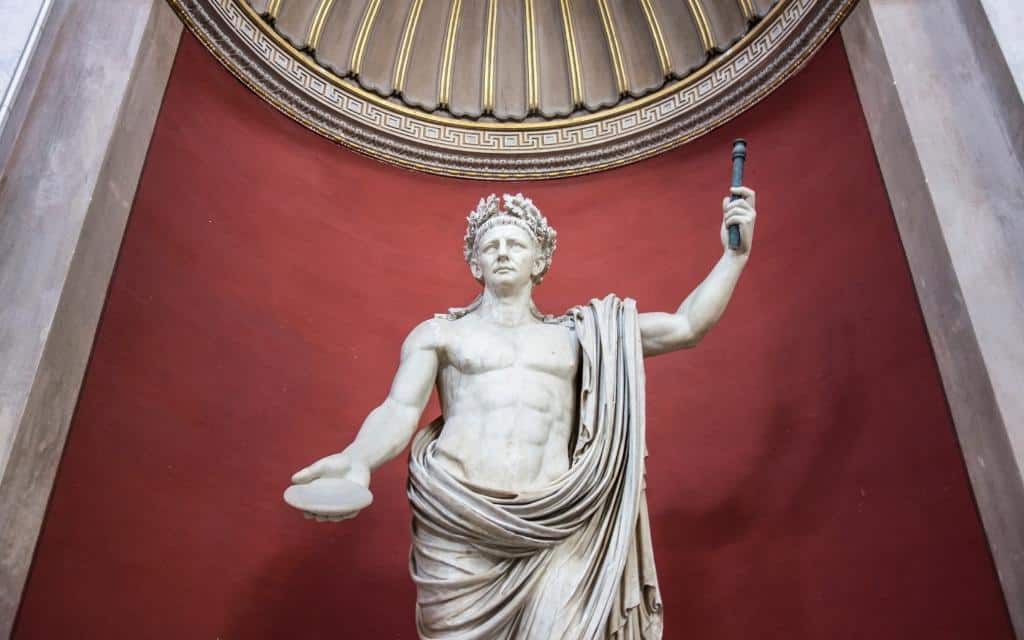
As for the time of day, it is no longer the case that there are fewer people later in the afternoon. We were here after 2pm and the line was insane. In addition, more crowds streamed from St Peter’s Square to the Vatican Museums.
If you plan to visit the first basilica of St. Peter, you can go here at 7 o’clock, when it opens. There’s never been a queue this early in the morning.
Choose quieter days Tuesday, Thursday and Friday. It is crowded on Saturdays, Mondays and Wednesdays, when the Pope has an audience in St Peter’s Square (in winter in the hall to the left of the Basilica). Thousands of people come to see the Pope in the morning, and many of them plan to visit St Peter’s Basilica and the Vatican Museums before or afterwards. St Peter’s Basilica is closed for the audience until about 12:30.
For myself, I would not recommend visiting the Vatican Museums on the last Sunday of the month. Admission is free, but queues can be several hours. But if you want to save some euros, come at 8 o’clock and join the queue (museums open at 9 o’clock).
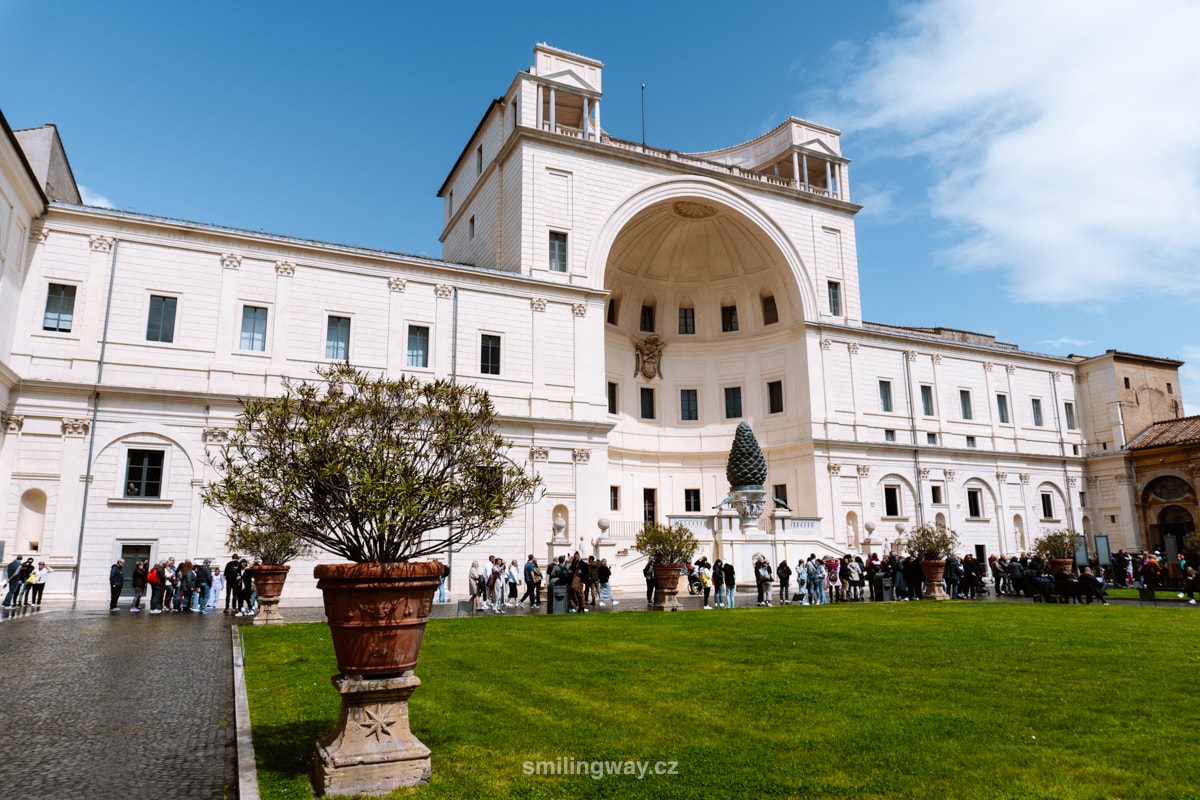
What to see in the Vatican Museums?
The Vatican Museums complex is housed in the Palazzo Apostolico. A huge complex with galleries connected by several kilometres of corridors. I would recommend taking a map at the entrance to the Vatican Museums at the beginning, which will help you a lot in orientation if you have certain places in mind.
The visit will take 2-3 hours of your time, but you won’t have a chance to see each work carefully. There is one main route through the Vatican Museums, leading through the Sistine Chapel. If you don’t stop, the trip to the chapel will take you half an hour. The Vatican Museums are spread over 2 floors:
On the first floor you will find:
- Pinakothek – a collection of significant paintings
- Pio-Clementine Museum – Gallery of Greek and Roman sculptures
- Chiaramonti Museum – Exhibition of Roman sculptures
- Egyptian Museum – exhibits with Assyrian and Egyptian finds from 2,000 years ago
- Etruscan Museum – artifacts from the Etruscan period
The Chiaramonti Museum and the Egyptian and Etruscan Museums are very specific. If you are not so interested in this period, I would skip them.
The second floor houses:
- Tapestry Gallery – beautiful tapestries woven from wool, silk, gold and silver threads
- Map Gallery – Old and incredibly accurate maps of Italy and its provinces
- Raphael’s rooms and apartments Borgia – rooms decorated with frescoes, the most famous of which is the painting School of Athens
What places not to miss in the Vatican Museums? I’ve attached a list of the top places and why you need to see them:

Pinacoteca (Pinakothek, Picture Gallery)
The Pinakothek should not be missed by anyone who has a passion for the paintings of the great masters from the Middle Ages to the 19th century. You will find more than 450 of them here, displayed chronologically in a total of 18 rooms.
One of his best works is Raphael’s Transfiguration, which he painted just before his death (he reportedly died of a fever after having a lot of sex at the age of 37). It is all the more important because it forms a bridge between High Renaissance and Baroque painting.
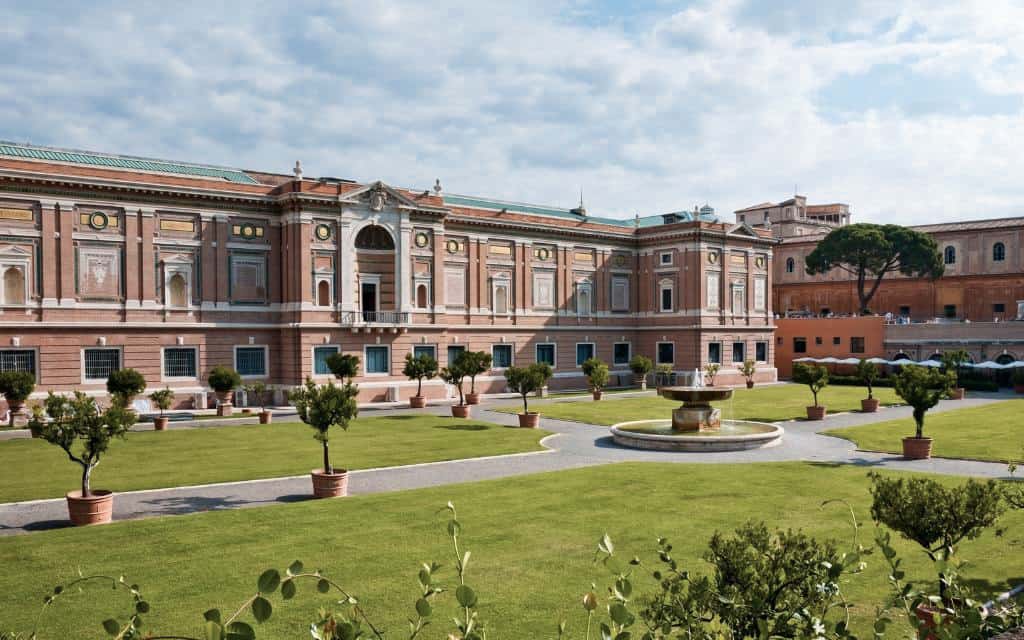
Another important work is the unfinished painting Saint Jeromein the wilderness by Leonardo da Vinci in room no. 9. Despite the fact that Da Vinci painted thousands of paintings, only 15 have survived, and you can find one of them right here in the Pinacoteca in the Vatican Museums.
His other works can be seen in the Church of Santa Maria delle Grazie in Milan, the Louvre in Paris, the Uffizi Gallery in Florence, the National Gallery in London and the Gallerie dell’Accademia in Venice.
Pinacoteca is located outside the main route. As soon as you enter the Vatican Museums and go down the escalator, you go outside where you will see signs. I recommend coming here first and then returning to the main route.
Braccio Nuovo (New Wing)
Braccio Nuovo has been closed for many years. It is a magnificent gallery with 28 niches that contain statues of emperors and Roman replicas of famous Greek statues. The busts on the consoles and half-columns then represent a gallery of famous names from antiquity.
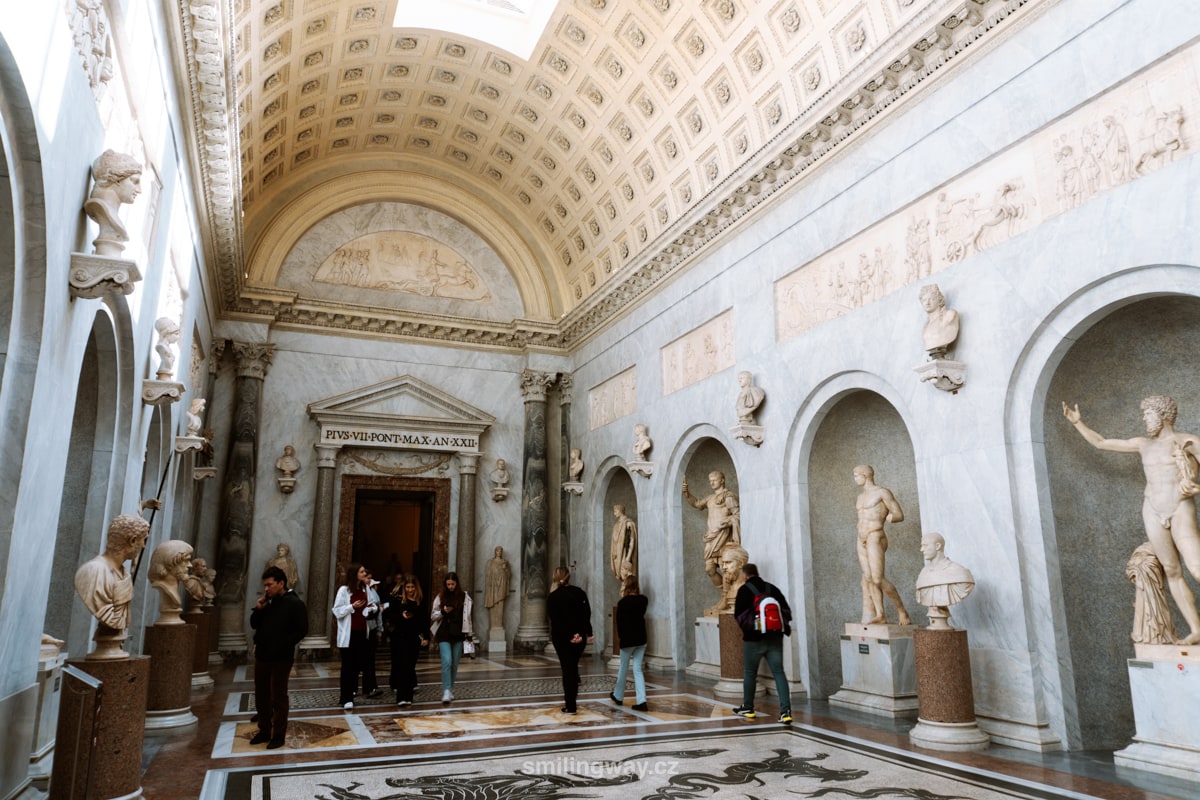
Cortile della Pigna (Pinecone Courtyard)
The Cortile della Pigna is the first courtyard in the museums where you can relax and recharge your batteries for more art. But besides that, it hides several important places.
It takes its name from a giant bronze pine cone that was once a fountain. It comes from 1st century BC and was found near the Pantheon. On either side of the cone are two bronze peacocks, which are copies of ancient statues from the villa of Emperor Hadrian in Tivoli. You will see the originals in the Braccio Nuovo wing.
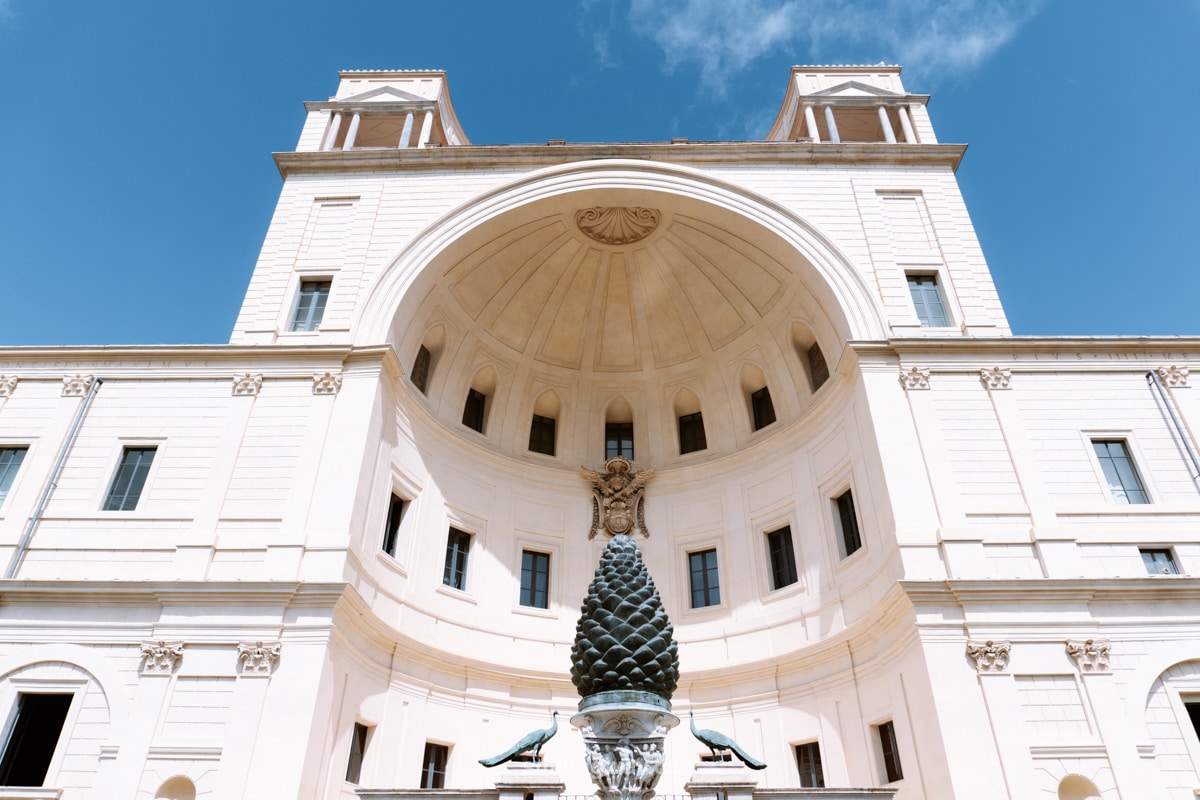
In the middle of the courtyard is a striking bronze statue of Sfera con Sfera by sculptor Arnaldo Pomodor. It consists of smaller spheres within a large sphere, which symbolize the relationship of the religious world to the world as such. The sculptor also created other versions of this sphere, which you can see, for example, at Trinity College in Dublin or at the UN offices in New York .
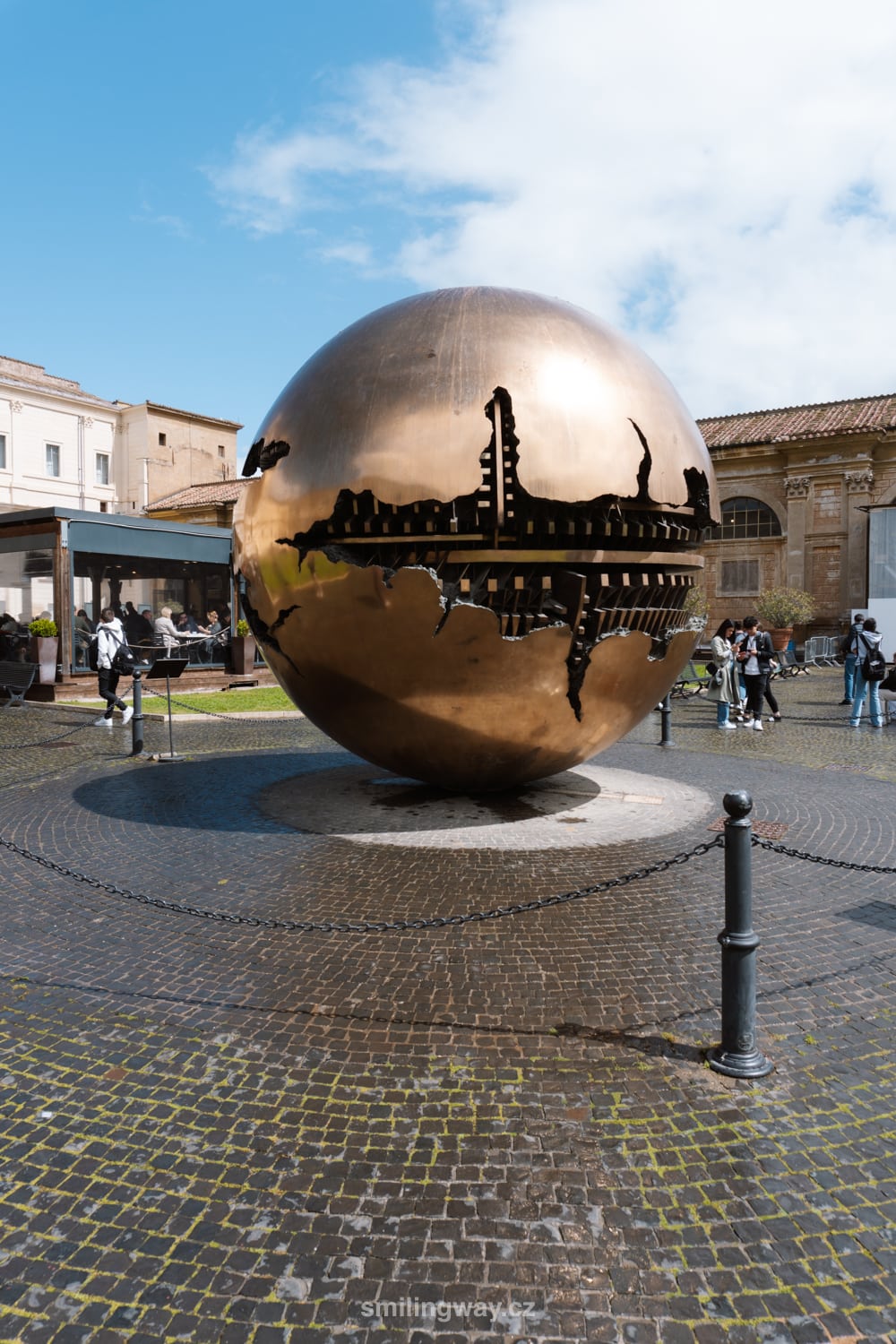
Another interesting feature is the huge bust of the first Roman emperor Caesar Augustus , who was emperor in the time of Christ.
Museo Pio Clementino (Pio-Clementine Museum)
The Pio-Clementine Museum is named after 2 popes (Clement XIV and Pius VI) who oversaw its founding in the late 19th century. The museum exhibits ancient Greek and Roman statues from around the world.
The most interesting place in the Museo Pio Clementino is Sala Rotonda. It was created on the model of the Roman Pantheon. In the middle stands a huge porphyry tank from the Golden House of Emperor Nero.
If you see it with your own eyes, you will be surprised to know that it was made from just one piece of stone in Egypt and then transported to Rome. Porphyry itself is very strong and heavy. Moreover, its purple color symbolized the royal family at that time.
Don’t miss a glimpse of the mosaic floor, which was taken piece by piece from the ancient baths in the ancient Roman port of Ostia Antica and tells the story of the battle of the Centaurs.
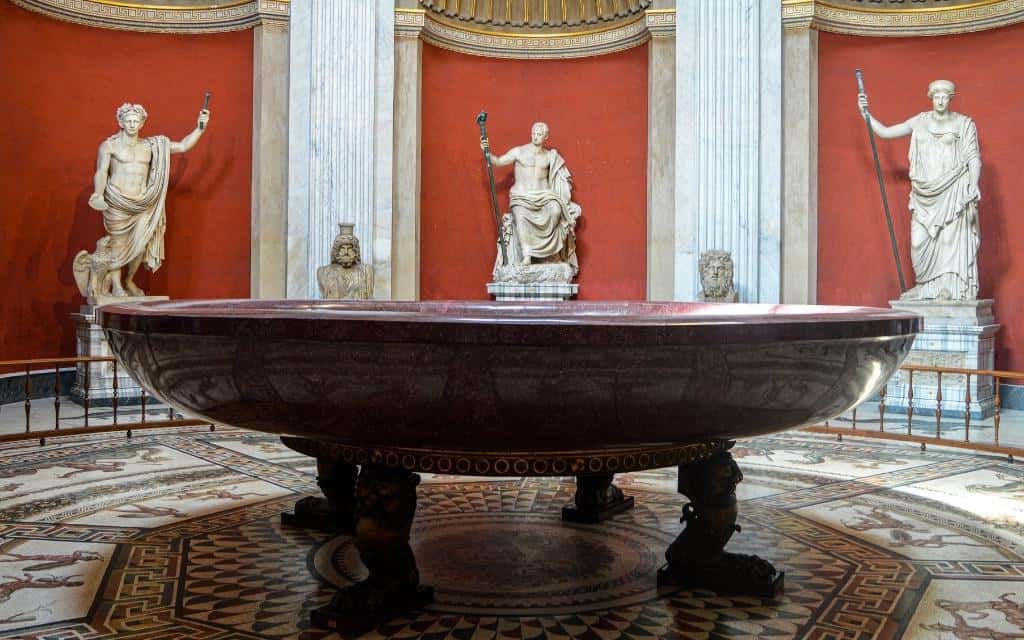
And what is the must-see statue in the Museo Pio Clementino? Certainly one of the most famous and valuable statues in the worldLaocoon and his sonswhich was discovered near the church of Santa Maria Maggiore (a short walk from Termini station) in 1506.
It is said to have decorated the palace of Emperor Titus and was lost for a millennium after the fall of the Roman Empire. After its discovery, Michelangelo pushed for its restoration and urged Pope Julius II to buy it. It became the reason for the opening of the Vatican Museums and the first art object.
Michelangelo also drew inspiration from it for his frescoes in the Sistine Chapel. You will see the statue in the middle of the octagonal courtyard from the 18th century with 3 fountains, trees and benches.
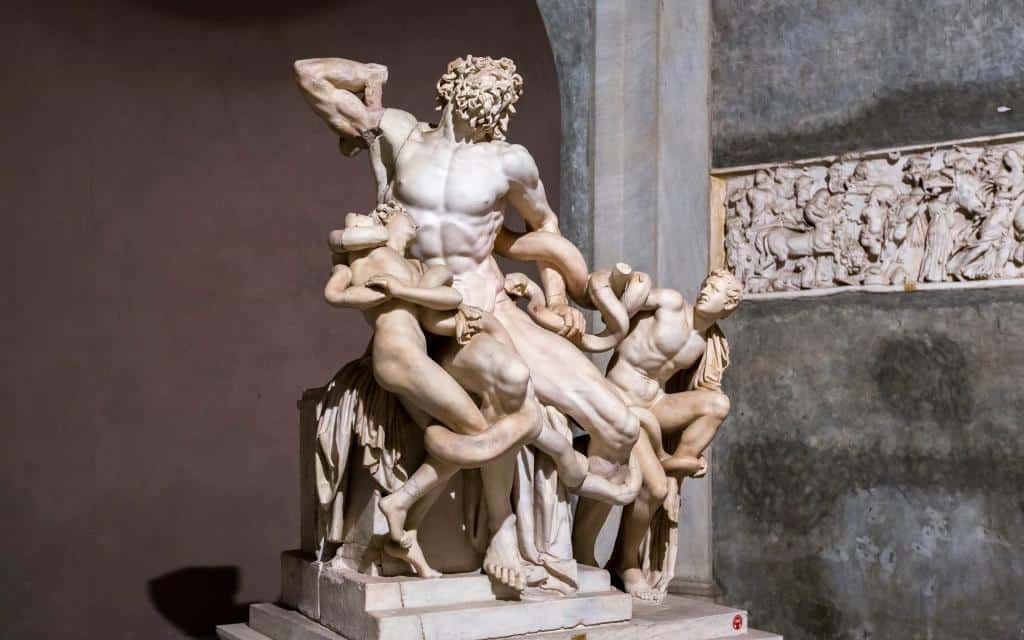
Galleria degli Arazzi (Tapestry Hall)
You will walk through the tapestry hall on the main route to the Sistine Chapel . Every tapestry here has been made for years from wool, silk, gold and silver threads by the best weavers in Flanders. Even if you are not interested in tapestries, make a short stop at theResurrection of Christ tapestry.
This is an example of moving perspective, a technique known, for example, from the Mona Lisa. Her eyes follow you wherever you stand. And this is exactly the case with the eyes of Jesus, but with the difference that creating a moving perspective in a tapestry is even more complicated.
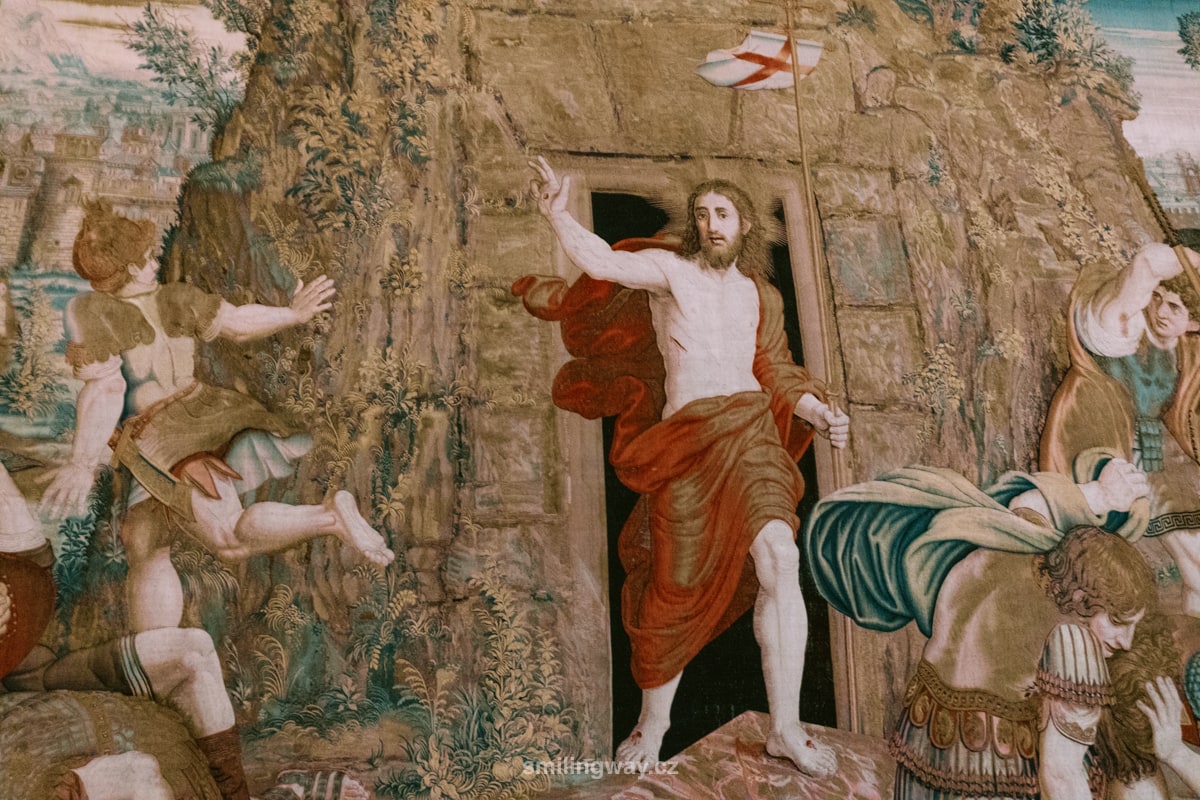
Geographic Map Gallery (Map Gallery)
A place at the top of my list due to the fact that I studied geography and am interested in everything related to it :). The map gallery is the largest collection of geographical paintings depicting Italy and the Italian provinces.
They are detailed and, considering their age at 400 years, incredibly accurate (reportedly up to 80%). Look carefully and on some maps you will also see sea creatures or the Roman god of the sea Neptune. At the end of the room there is a map of Venice, which you can use today. Venice has hardly changed over the centuries.
In addition to the maps, the gallery is famous for its beautiful ceiling with Bible stories. The Map gallery is part of the main route.
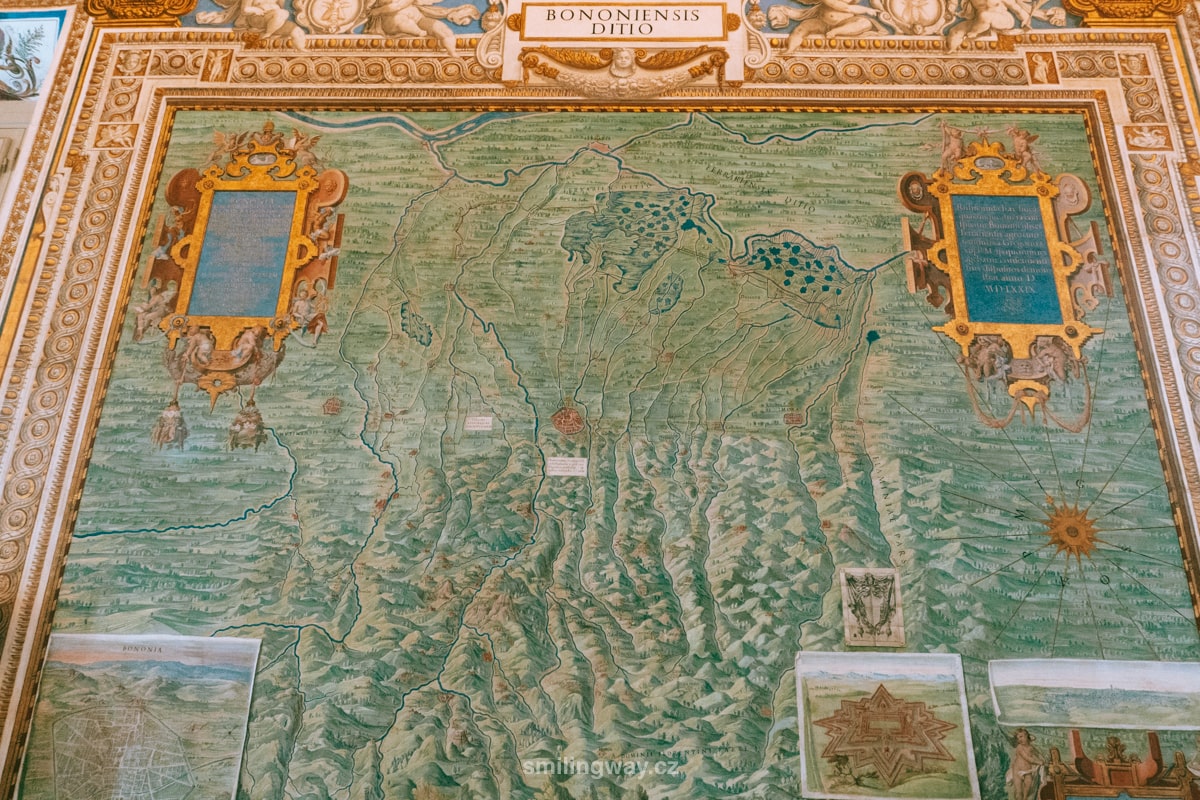
Papal apartments
The papal apartments have nothing to do with the private apartments of the current Pope. They consist of the Borgia Apartments and Rafael Rooms.
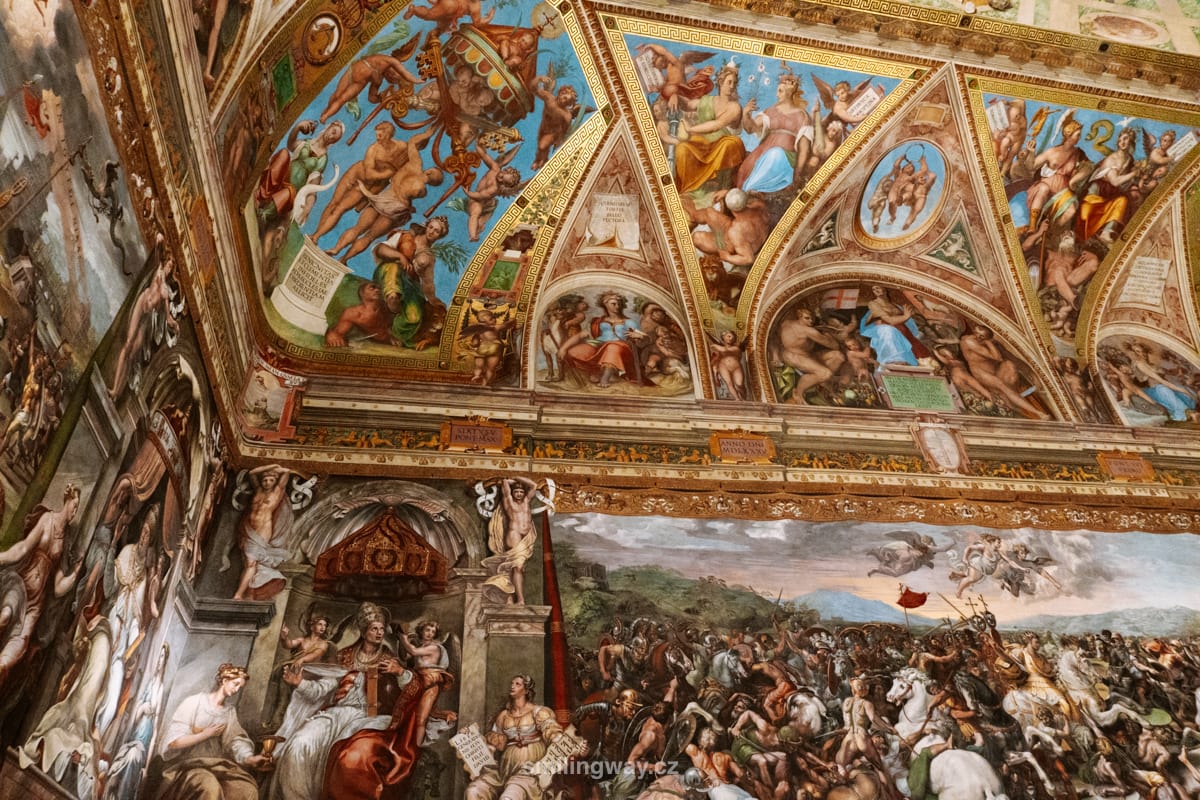
Most visitors head mainly for Rafael’s rooms and easily overlook the Borgia apartments, which is a great pity. The Borgia Apartments are located behind the Raphael Rooms and are decorated with beautiful frescoes by Pinturicchio.
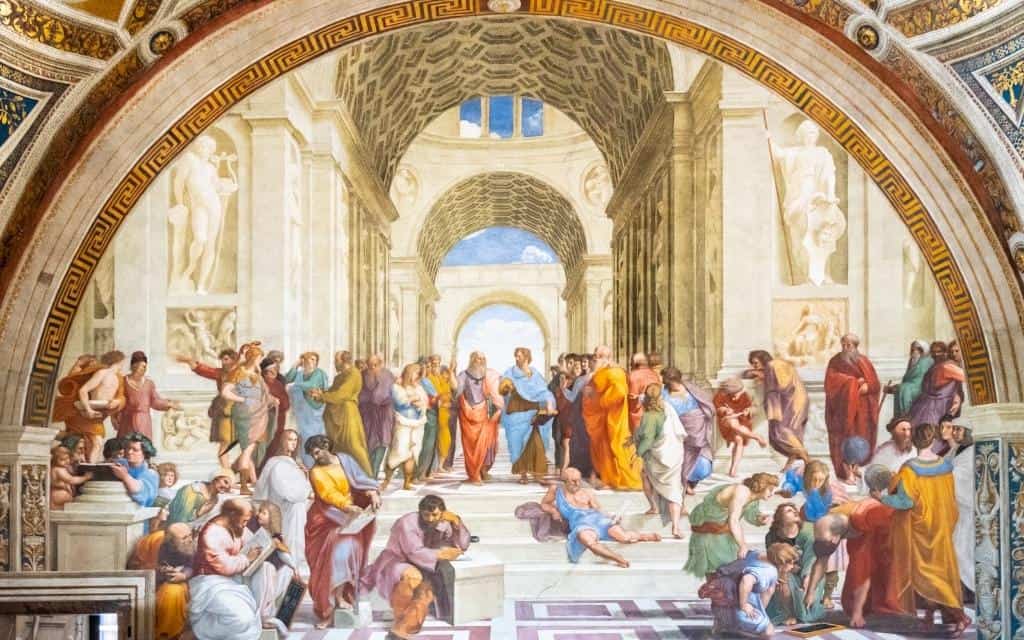
Raphael’s rooms were formerly the private chambers of Pope Julius II. He had Raphael called in to paint four rooms with frescoes. The most famous painting is the School of Athens (see above), which depicts a fictional meeting of the greatest philosophers and thinkers of classical antiquity. He immortalised them all on one canvas, even though they come from different places and different moments in time.
The central figures are Aristotle and Plato, who was given the face of Leonardo da Vinci as a tribute. If you look down in the painting, you will see a seated figure of a man crouched in the foreground.
And if you look even closer, you’ll notice it has the face of Michelangelo. At the time Raphael was working at the School of Athens, Michelangelo was painting frescoes in the Sistine Chapel. Annoyed Michelangelo and then popular Raphael, who overshadowed Michelangelo’s radiant personality, were not exactly in love.
Please note: It is easy to miss the entrance to the Papal Apartments – you must walk the entire route to get through, rather than taking the shortcut to the Sistine Chapel.
Spiral staircase
Some sources erroneously state that the staircase, located at the very end of the Vatican Museums, was designed by the famous architect Donato Bramante. But it’s not like that.
The real Bramante Staircase is not usually seen in the Vatican Museums. The famous staircase at the exit of the museums was designed by architect Giuseppe Momo in 1932 and was only inspired by Bramante’s staircase.
There are two spiral staircases, one leading down and the other up (today only the staircase downwards is accessible).
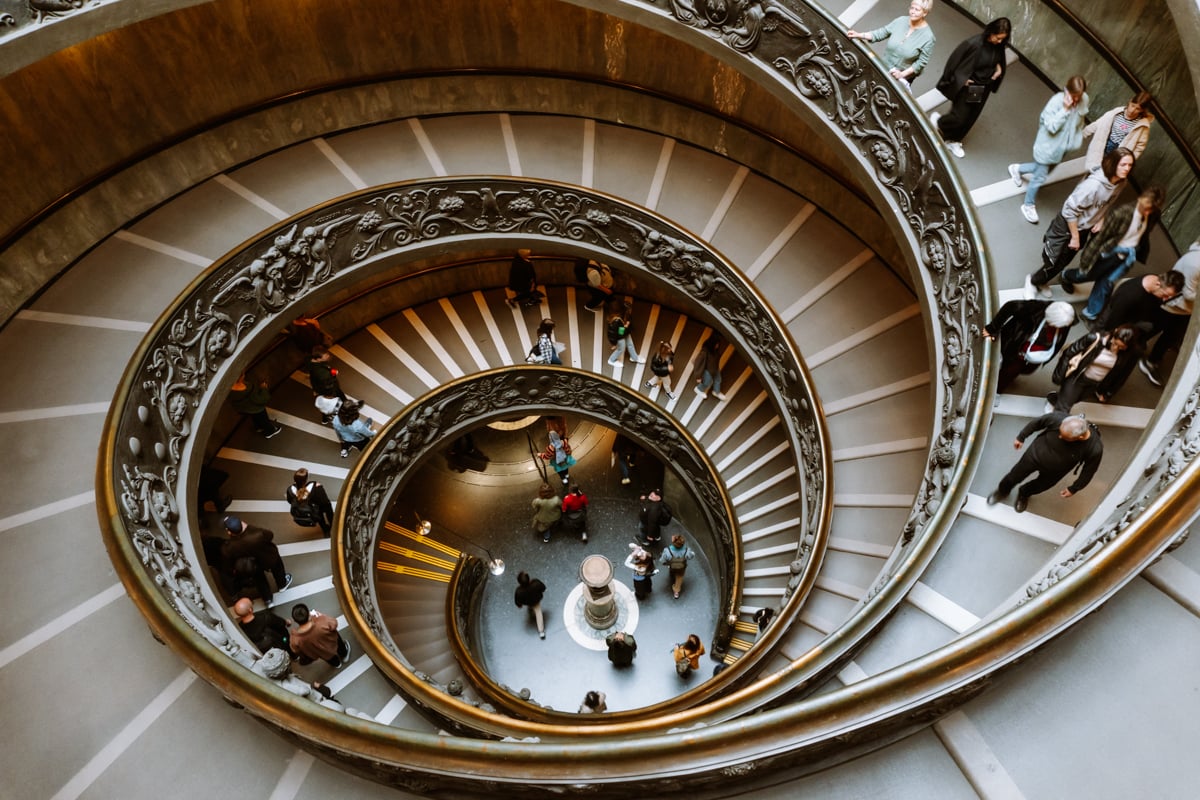
Sistine Chapel
For many people, the Sistine Chapel is the reason they want to visit the Vatican Museums. Thousands of people pay tribute to the talent of Michelangelo Buonarroti every day. The ceiling depicting scenes from the Book of Genesis and the Last Judgement fresco behind the altar will take the breath away of almost every visitor.
Sistine Chapel I have dedicated an entire article to it, where you can find out more interesting facts.
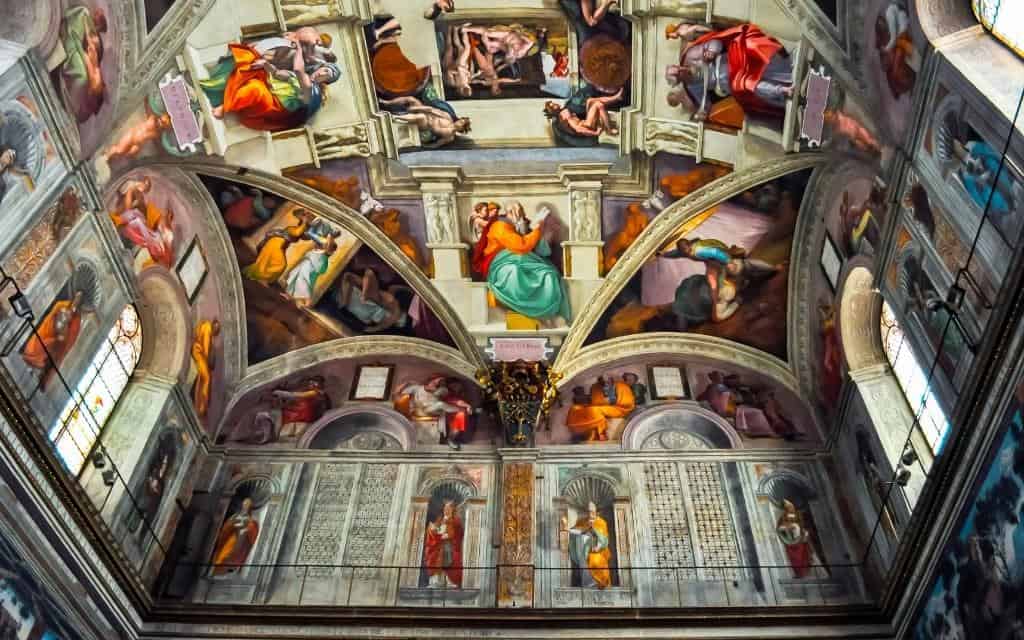
See even more photos of the Vatican Museums.
Tips before visiting
- There is a cafeteria in the Vatican Museums where you can eat, but to be honest, the food is not very good. I recommend eating in advance because you will spend a lot of time here and the tour can be exhausting.
- If you plan to visit St. Peter’s Basilica and the Vatican Museums in one day, I recommend eating in the Borgo district, which lines the Vatican walls on one side (where you’ll walk). There are some great restaurants here – for a quick Italian meal I recommend Pastasciutta.
- There is another point to this – take comfortable shoes. You come here a lot. If you go around everything, the route is 7.5 kilometers long.
- There are not many places to rest in the Vatican Museums – benches are in the Pinecone Courtyard, in the Map Gallery or the Sistine Chapel.
- You can take pictures in the Vatican Museums, but without a flash. Photography is forbidden in the Sistine Chapel.
- Toilets are right at the entrance and exit and in several other places in the museum.
- Dress appropriately. Feel free to wear jeans and a t-shirt, but cover your knees, shoulders, stomach, and possibly your legs. take your hat off your head. Sometimes the control is lighter and you are allowed in even in shorts, but if you encounter a stricter control, you will not be allowed in.
- The Vatican Museums are part of the Roma & Vatican Pass .
Booking tickets for the Vatican Museums and the Sistine Chapel
Map of Vatican
HOW TO USE THIS MAP: Above you will find a detailed map of Vatican. Click at the top left of the map to see separate layers with highlighted locations. You can hide and show the different layers or click on the icons on the map to show the names of the places I mention in the Vatican Museums Guide. If you want to save the map, star it. For a larger version, click on the icon in the upper right corner.
How to save in Rome on transport and admission?
It is very easy to save in Rome thanks to Roma Pass tourist card. With it, you get free admission to the most famous sights and reduced admission to many other places. The card also includes unlimited travel around Rome and the use of information points with public toilets and the possibility to get a phone (this is always useful in cities, what we will talk about).
Accommodation in Rome
- Hotel Impero – cheap hotel with excellent breakfast and roof terrace; older facilities but clean and cosy; quiet at night
- Hotel Borromeo – 3* hotel with air conditioning and roof terrace; minutes from the metro and within walking distance of the historic centre
- The Hive hotel – 4* hotel with modern and clean rooms; rooms and suites for up to 4 people available; spacious roof terrace with seating and restaurant
- hu Roma Camping in Town – accommodation in air-conditioned bungalows or chalets, restaurant, refreshments, free parking, jacuzzi, swimming pool, bar
Hotels in Rome 😴
This was our guide to visiting the Vatican Museums. Do you have any questions? We’ll be happy to answer them in the comments below. Have a safe journey!
More about Rome
THE BEST PLACES TO VISIT IN ROME: In our article on what to visit in Rome, you will find detailed descriptions of the most beautiful places, including information on admission fees and opening times. We also have special guides for the monuments of ancient Rome or the best museums in Rome.
Read the guide to the Colosseum to avoid queues on site. What not to miss in the Sistine Chapel is covered in a separate article. See photos of the Vatican Museums.
ITINERARY FOR ROME: Get inspired by our itinerary for Rome in 3 days. You only have one day? The itinerary for Rome in 1 day will help you plan the perfect trip.
ACCOMMODATION IN ROME: We’ve created a detailed guide on where to stay in Rome (best neighbourhoods and accommodation on a budget, a map and how to get from your accommodation to the sights or the airport).
HOW TO ENJOY ROME: For tips on the best things to do in Rome, check out our article on what in. We also share some tips on how to save in Rome and more than 35 tips for travelling around Rome. In a separate article, you can find out about all the ways to get from Fiumicino Airport to the centre of Rome.
Frequently asked questions about the Vatican Museums
Viale Vaticano 51, Vatican City
Metro – red line A → Cipro or Ottaviano stop
The Vatican Museums are open Monday to Saturday from 8:00-19:00 (last entry at 17:00). From March, opening hours are extended to 20:00 on selected days in the high season, on Fridays and Saturdays (last entry at 18:00).
Closed on Sundays except the last Sunday of the month when it is open 9:00-14:00 (last entry at 12:30).
Full admission to the Vatican Museums costs €20 and reduced admission costs €8 (children over 6 and students under 26). Children up to 6 years of age and disabled children with disability over 74% are admitted free of charge. We booked our tickets in advance and I would recommend it to anyone planning to visit the Vatican Museums – we didn’t even wait 5 minutes at the venue, including the security check.
You don’t have to, but it’s highly recommended. In the high season, tickets sell out weeks in advance.
